Submitted:
14 December 2023
Posted:
15 December 2023
You are already at the latest version
Abstract
Keywords:
1. Introduction
- Releasing the Water Index and Polarization Information multi-modality dataset for water area segmentation of remote sensing. The proposed datasets are the first-ever to provide both water index modal and corresponding polarization information modal. Especially, the dataset contains the Cloud-Free Label automatically obtained by the proposed Multi-Model Decision Fusion algorithm, it could effectively alleviate the problem of labeled sample scarcity.
- We propose a multi-modality fusion and gated multi-filter U-shaped convolutional neural network, which introduces the GCT skip connection for adaptively focusing on more meaningful channels, as well as incorporates the proposed gated multi-filter inception module for fully utilizing the multi-modality information and handling the challenge due to the variety of water bodies in size and shape.
- Extensive experiments on three benchmarks, including WIPI (water index and SAR images), Chengdu (multispectral images) and GF2020 (optical images) datasets demonstrated that our MFGF-UNet model achieves favorable performance with lower complexity and better robustness against six competing approaches.
2. WIPI multi-modality dataset construction
2.1. Original Sen1Floods11 Dataset
2.2. Water Index Extraction
2.3. Obtaining cloud-free label
3. Methodology
3.1. U-shaped encoder-decoder
3.2. Skip connections with channel attention
3.3. Gated multi-filter inception module
4. Experiments
4.1. Dataset and Pre-processing
| Dataset | Image size | Number of Dataset | |||
|---|---|---|---|---|---|
| Total | Train set | Val set | Test set | ||
| WIPI | (512,512,9) | 446 | 221 | 85 | 140 |
| Chengdu | (512,512,5) | 1681 | 1008 | 336 | 337 |
| GF2020 | (492,492,3) | 1000 | 600 | 200 | 200 |
4.2. Experimental Setup and Evaluation Metrics
4.3. Ablation studies
| Method | Enc & Dec | Inception | GCT | ACC(%) | MIoU(%) | F1(%) | Param(M) | GFLOPs |
|---|---|---|---|---|---|---|---|---|
| AS1 | ✓ | 98.09(±0.04) | 83.92(±0.31) | 91.26(±0.18)(↓0.65) | 27.36 | 15.74 | ||
| AS2 | ✓ | ✓ | 98.21(±0.01) | 84.82(±0.15) | 91.79(±0.08)(↓0.12) | 27.53 | 21.04 | |
| AS3 | ✓ | ✓ | 98.13(±0.03) | 84.21(±0.28) | 91.43(±0.16)(↓0.48) | 27.37 | 15.75 | |
| MFGF-UNet | ✓ | ✓ | ✓ | 98.22(±0.01) | 85.03(±0.18) | 91.91(±0.11) | 27.53 | 21.05 |
| Method | Modality | No. channel | ACC(%) | MIoU(%) | F1(%) | Param(M) | GFLOPs |
|---|---|---|---|---|---|---|---|
| MFGF-UNet | SAR | 2 | 95.52(±0.06) | 63.18(±0.60) | 77.68(±0.79)(↓14.23) | 1.36 | 1.04 |
| MSI | 13 | 97.55(±0.04) | 79.79(±0.29) | 88.76(±0.18)(↓3.15) | 57.43 | 43.79 | |
| WI | 7 | 97.79(±0.05) | 81.38(±0.39) | 89.73(±0.24)(↓2.18) | 16.65 | 12.71 | |
| WIPI | 9 | 98.22(±0.01) | 85.03(±0.18) | 91.91(±0.11) | 27.53 | 21.04 |
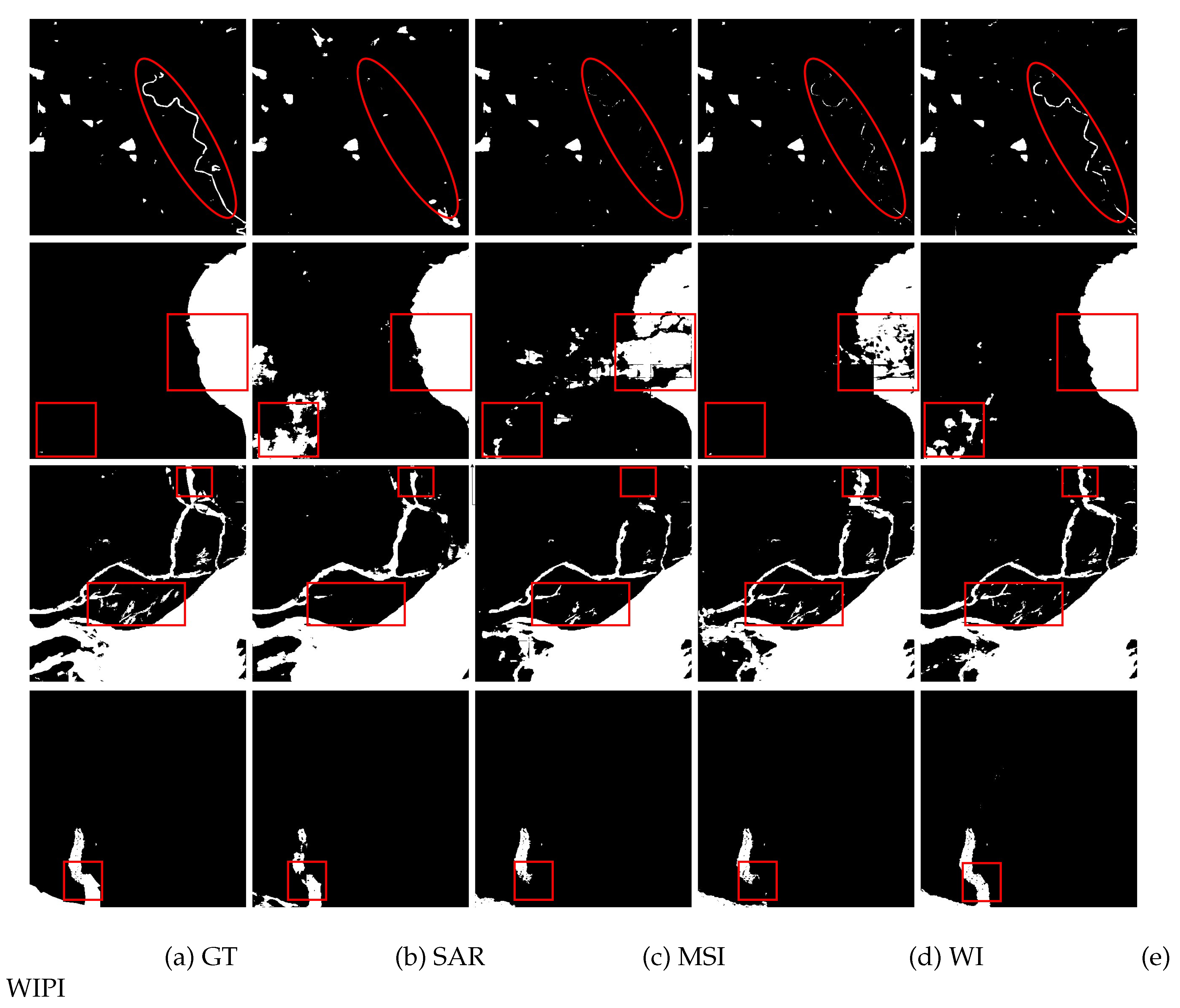
4.4. Comprehensive comparison with other methods
| Method | Dataset | No. channel | ACC(%) | MIoU(%) | F1(%) | Param(M) | GFLOPs |
|---|---|---|---|---|---|---|---|
| ]2*FCN-8s[12] | Sen1Floods11 | 15 | 96.04(±0.28) | 68.12(±1.91) | 81.02(±1.36) | 46.25 | 2.01 |
| WIPI | 9 | 96.83(±0.06) | 73.95(±0.62) | 85.02(±0.41)(↑4.00) | 46.24 | 1.98 | |
| ]2*U-Net[14] | Sen1Floods11 | 15 | 96.53(±0.46) | 72.84(±2.47) | 84.26(±1.64) | 49.89 | 26.91 |
| WIPI | 9 | 98.09(±0.04) | 84.07(±0.21) | 91.35(±0.12(↑7.09)) | 49.89 | 26.69 | |
| ]2*DeepLabv3+[19] | Sen1Floods11 | 15 | 96.43(±0.34) | 71.88(±1.91) | 83.62(±1.28) | 6.43 | 2.10 |
| WIPI | 9 | 97.37(±0.03) | 78.22(±0.33) | 87.78(±0.21)(↑4.16) | 6.43 | 2.09 | |
| ]2*BASNet[20] | Sen1Floods11 | 15 | 97.30(±0.06) | 78.14(±0.17) | 87.73(±0.10) | 87.08 | 31.99 |
| WIPI | 9 | 97.91(±0.07) | 82.92(±0.45) | 90.66(±0.27)(↑2.93) | 87.07 | 31.93 | |
| ]2*DUPNet[1] | Sen1Floods11 | 15 | 95.16(±0.24) | 66.06(±1.18) | 79.55(±0.86) | 49.87 | 69.20 |
| WIPI | 9 | 98.01(±0.07) | 83.23(±0.66) | 90.85(±0.40)(↑11.30) | 49.86 | 69.17 | |
| ]2*SegNeXt[24] | Sen1Floods11 | 15 | 96.67(±0.10) | 72.15(±1.08) | 83.81(±0.73) | 27.54 | 2.02 |
| WIPI | 9 | 97.11(±0.17) | 76.38(±1.21) | 86.60(±0.78)(↑2.79) | 27.54 | 2.01 | |
| ]2*MFGF-UNet(ours) | Sen1Floods11 | 15 | 96.11(±0.53) | 70.52(±2.64) | 82.68(±1.84) | 76.46 | 58.37 |
| WIPI | 9 | 98.22(±0.01) | 85.03(±0.18) | 91.91(±0.11)(↑9.23) | 27.53 | 21.05 |
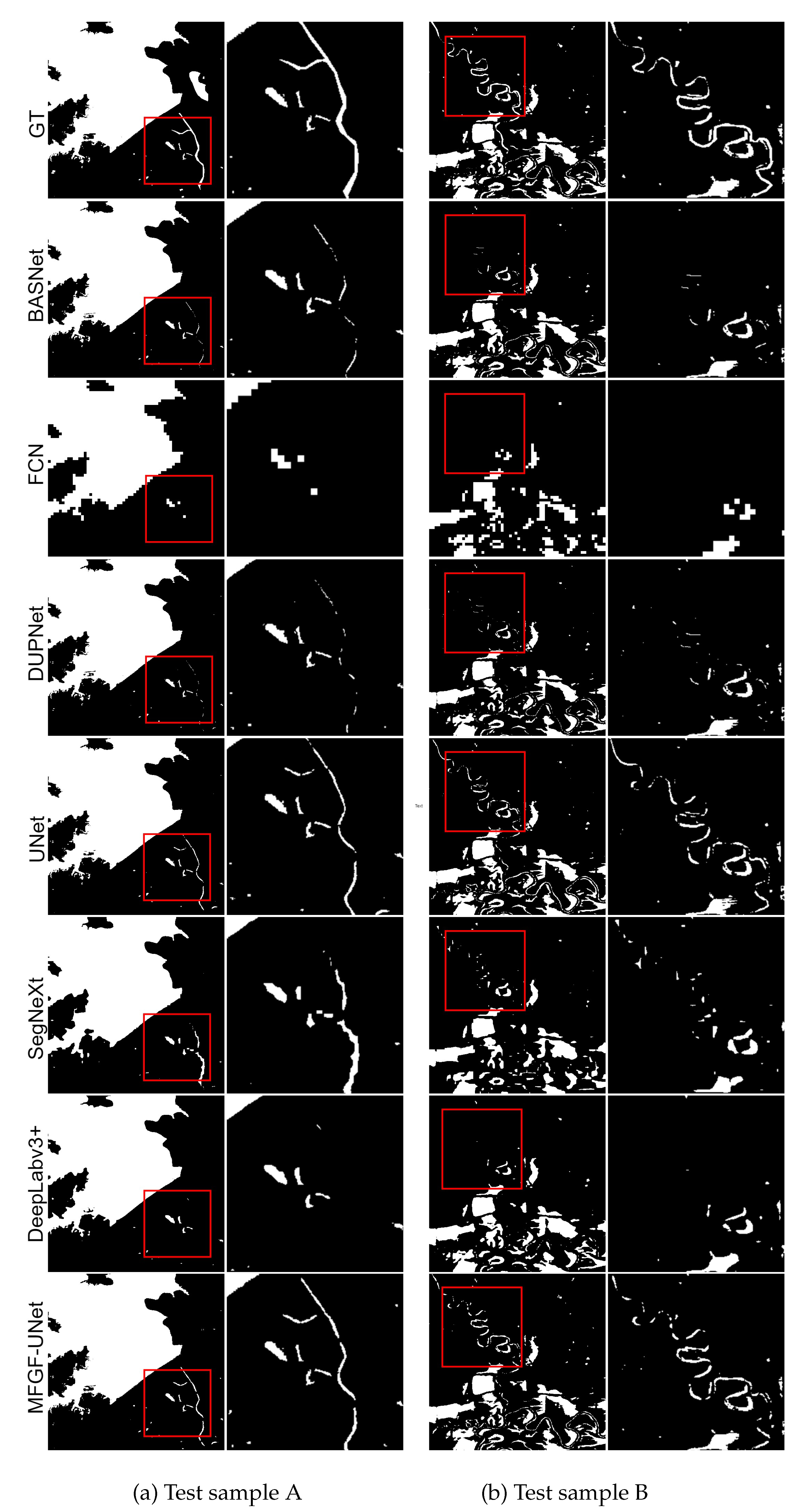
4.5. Evaluation of the model robustness
| Method | DataSet | ACC | MIoU | F1 | Params (M) | GFLOPs |
|---|---|---|---|---|---|---|
| ]2*FCN-8s[12] | Chengdu | 98.56(±0.01) | 45.78(±0.76) | 62.71(±0.64) | 46.25 | 1.96 |
| GF2020 | 93.12(±0.01) | 70.83(±0.22) | 82.93(±0.15) | 46.25 | 1.95 | |
| ]2*U-Net[14] | Chengdu | 98.91(±0.01) | 58.02(±0.61) | 73.42(±0.49) | 49.88 | 26.54 |
| GF2020 | 93.69(±0.11) | 72.72(±0.77) | 84.10(±0.51) | 49.88 | 26.46 | |
| ]2*DeepLabv3+[19] | Chengdu | 98.86(±0.01) | 55.96(±0.50) | 71.76(±0.41) | 6.43 | 2.09 |
| GF2020 | 92.56(±0.16) | 68.86(±0.90) | 81.55(±0.63) | 6.43 | 2.09 | |
| ]2*BASNet[20] | Chengdu | 98.90(±0.01) | 59.69(±0.12) | 74.75(±0.09) | 87.07 | 31.89 |
| GF2020 | 93.45(±0.16) | 74.11(±0.35) | 85.13(±0.23) | 87.07 | 31.87 | |
| ]2*DUPNet[1] | Chengdu | 98.87(±0.01) | 56.87(±0.72) | 72.50(±0.58) | 49.86 | 69.16 |
| GF2020 | 93.79(±0.06) | 74.27(±0.09) | 85.23(±0.06) | 49.86 | 69.15 | |
| ]2*SegNeXt[24] | Chengdu | 98.84(±0.01) | 55.29(±0.13) | 71.21(±0.11) | 27.54 | 2.01 |
| GF2020 | 93.06(±0.09) | 72.03(±0.26) | 83.74(±0.17) | 27.54 | 2.01 | |
| ]2*MFGF-UNet | Chengdu | 98.91(±0.01) | 58.85(±0.10) | 74.09(±0.08) | 8.50 | 6.49 |
| GF2020 | 93.63(±0.09) | 72.73(±0.45) | 84.21(±0.30) | 3.06 | 2.36 |
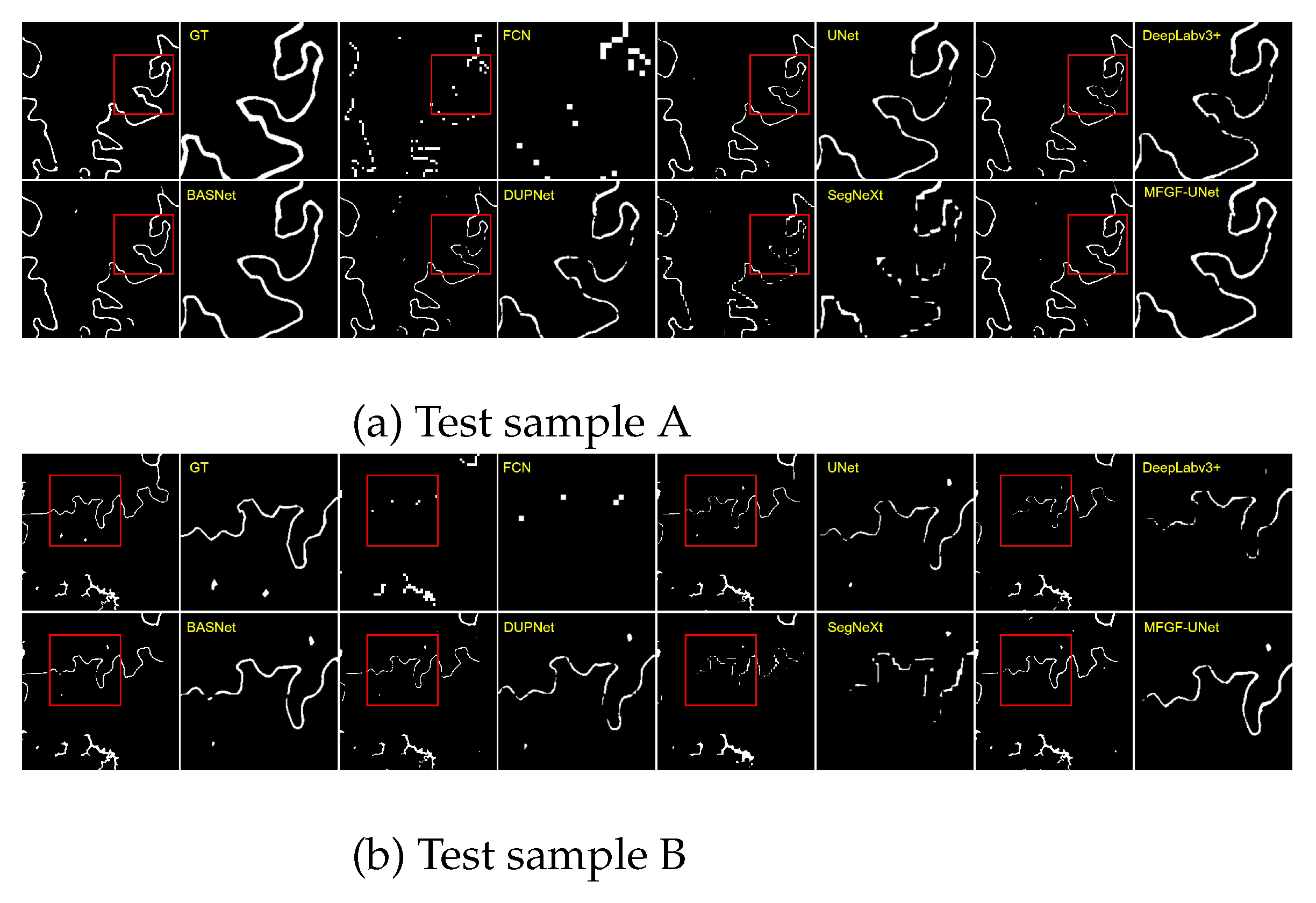
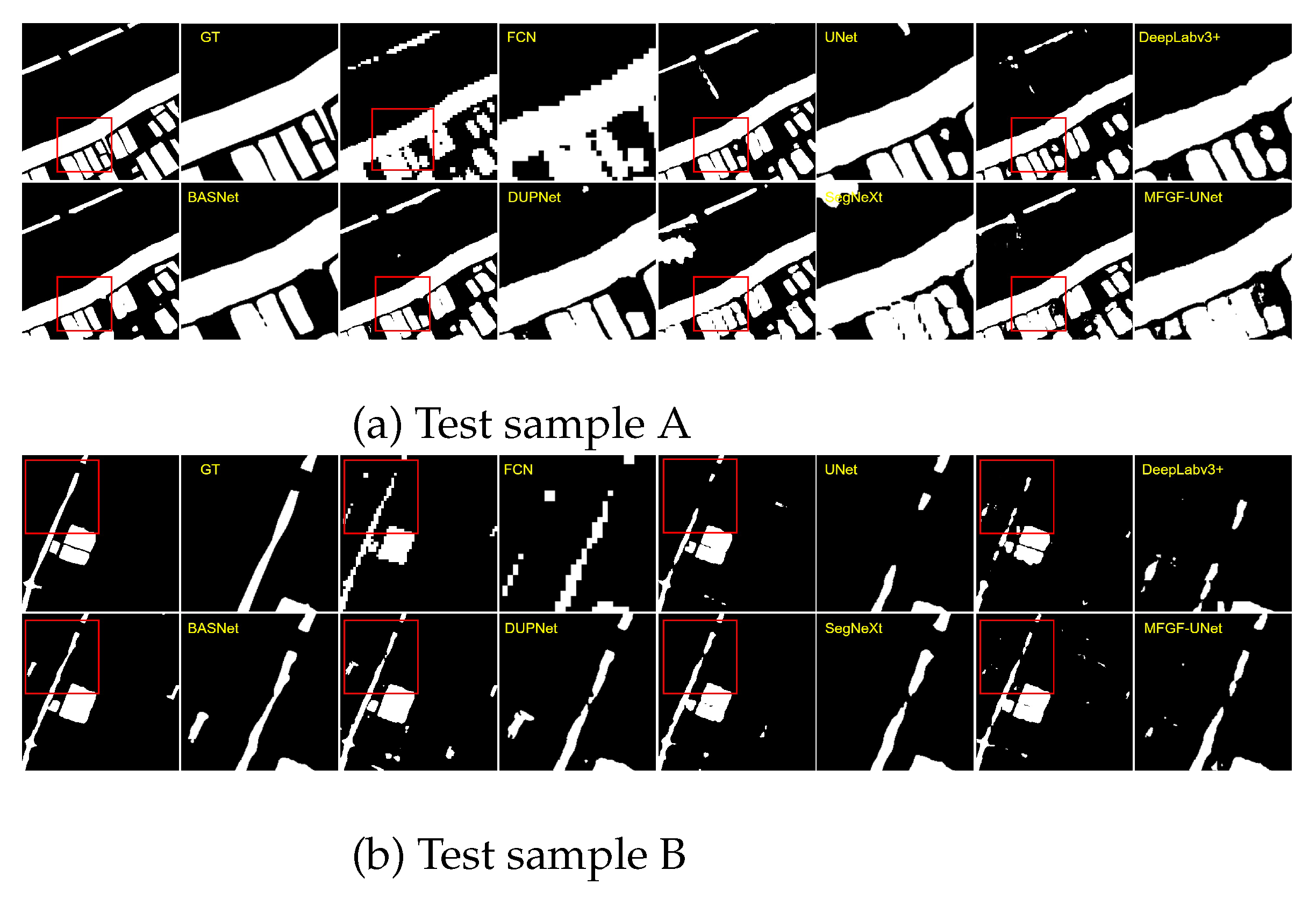
5. Discussion
6. Conclusions
Funding
Conflicts of Interest
Appendix A
Appendix A.1. The description of Sen1Floods11 dataset
| Modality | Value | Format | Bands |
|---|---|---|---|
| SAR | Unit:dB | GeoTIFF 512 × 512 2 bands Float32 |
0:VV 1:VH |
| MSI | Unit: TOA reflectance (scaled by 10000) |
GeoTIFF 512 × 512 13 bands UInt16 |
0: B1 (Coastal) 7: B8 (NIR) 1: B2 (Blue) 8: B8A (Narrow NIR) 2: B3 (Green) 9: B9 (Water Vapor) 3: B4 (Red) 10: B10 (Cirrus) 4: B5 (RedEdge-1) 11: B11 (SWIR-1) 5: B6 (RedEdge-2) 12: B12 (SWIR-2)6: B7 (RedEdge-3) |
Appendix A.2 The description of used seven water indexes
| Index | Name | Formula | Description |
|---|---|---|---|
| 1 | Normalized Difference Vegetation Index(NDVI)[40] |
(B8-B4)/(B8+B4) | High values indicate dense tree canopies, while low or negative values indicate urban areas and water bodies. |
|
2 |
Normalized Difference Moisture Index(NDMI)[41] |
(B8A-B11)/(B8A+B11) |
Vegetation with higher values is relatively moist. |
| 3 | Normalized Difference Water Index(NDWI)[26] |
(B3-B8)/(B3+B8) |
Highlights water bodies, suppresses vegetation information; susceptible to the influence of object shadows. |
| 4 |
Modified Normalized Difference Water Index (MNDWI)[27] |
(B3-B11)/(B3+B11) |
Eliminate the influence of buildings and land, high -light water bodies, and easily affected by shadows of objects. |
|
5 |
Automated Water Extraction Index (Non-Shadow,AWEINS)[42] |
(4B3-4B11)/(0.25B8+2.75B12) |
Remove black buildings that are easily misclassified as water bodies. |
|
6 |
Automated Water Extraction Index (Shadow,AWEIS)[42] |
B2+2.5B3-1.5 (B8+B11)-0.25B12 |
Suitable for scenes with a high amount of shadow. |
| 7 | Linear Discriminant Analysis Water Index(LDAWI)[43] |
1.7204+171B3+3B4- 70B8-45B11-71B12 |
Suitable for scenes where there is a large difference in spectral distribution between non-water and water bodies. |
References
- Liu, Z.; Chen, X.; Zhou, S.; Yu, H.; Guo, J.; Liu, Y. DUPnet: Water Body Segmentation with Dense Block and Multi-Scale Spatial Pyramid Pooling for Remote Sensing Images. Remote Sensing 2022, 14, 5567. [Google Scholar] [CrossRef]
- Konapala, G.; Kumar, S.V.; Ahmad, S.K. Exploring Sentinel-1 and Sentinel-2 diversity for flood inundation mapping using deep learning. ISPRS Journal of Photogrammetry and Remote Sensing 2021, 180, 163–173. [Google Scholar] [CrossRef]
- Li, Y.; Dang, B.; Zhang, Y.; Du, Z. Water body classification from high-resolution optical remote sensing imagery: Achievements and perspectives. ISPRS Journal of Photogrammetry and Remote Sensing 2022, 187, 306–327. [Google Scholar] [CrossRef]
- Liu, J.; Wang, Y. Water Body Extraction in Remote Sensing Imagery Using Domain Adaptation-Based Network Embedding Selective Self-Attention and Multi-Scale Feature Fusion. Remote Sensing 2022, 14, 3538. [Google Scholar] [CrossRef]
- Shen, X.; Wang, D.; Mao, K.; Anagnostou, E.; Hong, Y. Inundation extent mapping by synthetic aperture radar: A review. Remote Sensing 2019, 11, 879. [Google Scholar] [CrossRef]
- Longfei, S.; Zhengxuan, L.; Fei, G.; Min, Y. A review of remote sensing image water extraction. Remote Sensing for Natural Resources 2021, 33, 9–11. [Google Scholar]
- Cao, M.; Mao, K.; Shen, X.; Xu, T.; Yan, Y.; Yuan, Z. Monitoring the spatial and temporal variations in the water surface and floating algal bloom areas in Dongting Lake using a long-term MODIS image time series. Remote Sensing 2020, 12, 3622. [Google Scholar] [CrossRef]
- Shetty, S.; Gupta, P.K.; Belgiu, M.; Srivastav, S. Assessing the effect of training sampling design on the performance of machine learning classifiers for land cover mapping using multi-temporal remote sensing data and google earth engine. Remote sensing 2021, 13, 1433. [Google Scholar] [CrossRef]
- Razaque, A.; Ben Haj Frej, M.; Almi’ani, M.; Alotaibi, M.; Alotaibi, B. Improved support vector machine enabled radial basis function and linear variants for remote sensing image classification. Sensors 2021, 21, 4431. [Google Scholar] [CrossRef]
- Li, A.; Fan, M.; Qin, G.; Xu, Y.; Wang, H. Comparative analysis of machine learning algorithms in automatic identification and extraction of water boundaries. Applied Sciences 2021, 11, 10062. [Google Scholar] [CrossRef]
- Acharya, T.D.; Subedi, A.; Lee, D.H. Evaluation of machine learning algorithms for surface water extraction in a Landsat 8 scene of Nepal. Sensors 2019, 19, 2769. [Google Scholar] [CrossRef]
- Long, J.; Shelhamer, E.; Darrell, T. Fully convolutional networks for semantic segmentation. In Proceedings of the Proceedings of the IEEE conference on computer vision and pattern recognition, 2015, pp.; pp. 3431–3440.
- Simonyan, K.; Zisserman, A. Very deep convolutional networks for large-scale image recognition. arXiv 2014, arXiv:1409.1556. [Google Scholar]
- Ronneberger, O.; Fischer, P.; Brox, T. U-net: Convolutional networks for biomedical image segmentation. In Proceedings of the Medical Image Computing and Computer-Assisted Intervention–MICCAI 2015: 18th International Conference, Munich, Germany, 2015, Proceedings, Part III 18. Springer, 2015, October 5-9; pp. 234–241.
- Cui, M.; Li, K.; Chen, J.; Yu, W. CM-Unet: A novel remote sensing image segmentation method based on improved U-Net. IEEE Access 2023. [Google Scholar] [CrossRef]
- Wang, L.; Li, R.; Zhang, C.; Fang, S.; Duan, C.; Meng, X.; Atkinson, P.M. UNetFormer: A UNet-like transformer for efficient semantic segmentation of remote sensing urban scene imagery. ISPRS Journal of Photogrammetry and Remote Sensing 2022, 190, 196–214. [Google Scholar] [CrossRef]
- Chen, L.C.; Papandreou, G.; Kokkinos, I.; Murphy, K.; Yuille, A.L. Semantic image segmentation with deep convolutional nets and fully connected crfs. arXiv 2014, arXiv:1412.7062. [Google Scholar]
- Chen, L.C.; Papandreou, G.; Kokkinos, I.; Murphy, K.; Yuille, A.L. Deeplab: Semantic image segmentation with deep convolutional nets, atrous convolution, and fully connected crfs. IEEE transactions on pattern analysis and machine intelligence 2017, 40, 834–848. [Google Scholar] [CrossRef]
- Chen, L.C.; Zhu, Y.; Papandreou, G.; Schroff, F.; Adam, H. Encoder-decoder with atrous separable convolution for semantic image segmentation. In Proceedings of the Proceedings of the European conference on computer vision (ECCV), 2018, pp.; pp. 801–818.
- Qin, X.; Zhang, Z.; Huang, C.; Gao, C.; Dehghan, M.; Jagersand, M. Basnet: Boundary-aware salient object detection. In Proceedings of the Proceedings of the IEEE/CVF conference on computer vision and pattern recognition, 2019, pp.; pp. 7479–7489.
- He, K.; Zhang, X.; Ren, S.; Sun, J. Deep residual learning for image recognition. In Proceedings of the Proceedings of the IEEE conference on computer vision and pattern recognition, 2016, pp.; pp. 770–778.
- Huang, G.; Liu, Z.; Van Der Maaten, L.; Weinberger, K.Q. Densely connected convolutional networks. In Proceedings of the Proceedings of the IEEE conference on computer vision and pattern recognition, 2017, pp.; pp. 4700–4708.
- Dosovitskiy, A.; Beyer, L.; Kolesnikov, A.; Weissenborn, D.; Zhai, X.; Unterthiner, T.; Dehghani, M.; Minderer, M.; Heigold, G.; Gelly, S. An image is worth 16x16 words: Transformers for image recognition at scale. arXiv 2020, arXiv:2010.11929. [Google Scholar]
- Guo, M.H.; Lu, C.Z.; Hou, Q.; Liu, Z.; Cheng, M.M.; Hu, S.M. Segnext: Rethinking convolutional attention design for semantic segmentation. arXiv 2022, arXiv:2209.08575. [Google Scholar]
- Akiva, P.; Purri, M.; Dana, K.; Tellman, B.; Anderson, T. H2O-Net: Self-supervised flood segmentation via adversarial domain adaptation and label refinement. In Proceedings of the Proceedings of the IEEE/CVF Winter Conference on Applications of Computer Vision, 2021, pp.; pp. 111–122.
- McFeeters, S.K. The use of the Normalized Difference Water Index (NDWI) in the delineation of open water features. International journal of remote sensing 1996, 17, 1425–1432. [Google Scholar] [CrossRef]
- Xu, H. Modification of normalised difference water index (NDWI) to enhance open water features in remotely sensed imagery. International journal of remote sensing 2006, 27, 3025–3033. [Google Scholar] [CrossRef]
- Hu, J.; Shen, L.; Sun, G. Squeeze-and-excitation networks. In Proceedings of the Proceedings of the IEEE conference on computer vision and pattern recognition, 2018, pp.; pp. 7132–7141.
- Woo, S.; Park, J.; Lee, J.Y.; Kweon, I.S. Cbam: Convolutional block attention module. In Proceedings of the Proceedings of the European conference on computer vision (ECCV), 2018, pp.; pp. 3–19.
- Dai, J.; Qi, H.; Xiong, Y.; Li, Y.; Zhang, G.; Hu, H.; Wei, Y. Deformable convolutional networks. In Proceedings of the Proceedings of the IEEE international conference on computer vision, 2017, pp.; pp. 764–773.
- Carion, N.; Massa, F.; Synnaeve, G.; Usunier, N.; Kirillov, A.; Zagoruyko, S. End-to-end object detection with transformers. In Proceedings of the Computer Vision–ECCV 2020: 16th European Conference, Glasgow, UK, 2020, Proceedings, Part I 16. Springer, 2020, August 23–28; pp. 213–229.
- Yuan, Y.; Huang, L.; Guo, J.; Zhang, C.; Chen, X.; Wang, J. Ocnet: Object context network for scene parsing. arXiv 2018, arXiv:1809.00916. [Google Scholar]
- Fu, J.; Liu, J.; Tian, H.; Li, Y.; Bao, Y.; Fang, Z.; Lu, H. Dual attention network for scene segmentation. In Proceedings of the Proceedings of the IEEE/CVF conference on computer vision and pattern recognition, 2019, pp.; pp. 3146–3154.
- Oktay, O.; Schlemper, J.; Folgoc, L.L.; Lee, M.; Heinrich, M.; Misawa, K.; Mori, K.; McDonagh, S.; Hammerla, N.Y.; Kainz, B. Attention u-net: Learning where to look for the pancreas. arXiv 2018, arXiv:1804.03999. [Google Scholar]
- Guan, Q.; Huang, Y.; Zhong, Z.; Zheng, Z.; Zheng, L.; Yang, Y. Diagnose like a radiologist: Attention guided convolutional neural network for thorax disease classification. arXiv 2018, arXiv:1801.09927. [Google Scholar]
- Xie, S.; Liu, S.; Chen, Z.; Tu, Z. Attentional shapecontextnet for point cloud recognition. In Proceedings of the Proceedings of the IEEE conference on computer vision and pattern recognition, 2018, pp.; pp. 4606–4615.
- Su, W.; Zhu, X.; Cao, Y.; Li, B.; Lu, L.; Wei, F.; Dai, J. Vl-bert: Pre-training of generic visual-linguistic representations. arXiv 2019, arXiv:1908.08530. [Google Scholar]
- Xu, T.; Zhang, P.; Huang, Q.; Zhang, H.; Gan, Z.; Huang, X.; He, X. Attngan: Fine-grained text to image generation with attentional generative adversarial networks. In Proceedings of the Proceedings of the IEEE conference on computer vision and pattern recognition, 2018, pp.; pp. 1316–1324.
- Bonafilia, D.; Tellman, B.; Anderson, T.; Issenberg, E. Sen1Floods11: A georeferenced dataset to train and test deep learning flood algorithms for sentinel-1. In Proceedings of the Proceedings of the IEEE/CVF Conference on Computer Vision and Pattern Recognition Workshops, 2020, pp.; pp. 210–211.
- Rouse, J.W.; Haas, R.H.; Schell, J.A.; Deering, D.W.; et al. Monitoring vegetation systems in the Great Plains with ERTS. NASA Spec. Publ 1974, 351, 309. [Google Scholar]
- Jackson, R.D. Remote sensing of biotic and abiotic plant stress. Annual review of Phytopathology 1986, 24, 265–287. [Google Scholar] [CrossRef]
- Feyisa, G.L.; Meilby, H.; Fensholt, R.; Proud, S.R. Automated Water Extraction Index: A new technique for surface water mapping using Landsat imagery. Remote Sensing of Environment 2014, 140, 23–35. [Google Scholar] [CrossRef]
- Fisher, A.; Flood, N.; Danaher, T. Comparing Landsat water index methods for automated water classification in eastern Australia. Remote Sensing of Environment 2016, 175, 167–182. [Google Scholar] [CrossRef]
- Ioffe, S.; Szegedy, C. Batch normalization: Accelerating deep network training by reducing internal covariate shift. In Proceedings of the International conference on machine learning. pmlr; 2015; pp. 448–456. [Google Scholar]
- Glorot, X.; Bordes, A.; Bengio, Y. Deep sparse rectifier neural networks. In Proceedings of the Proceedings of the fourteenth international conference on artificial intelligence and statistics.; pp. 2011315–323.
- Yang, Z.; Zhu, L.; Wu, Y.; Yang, Y. Gated channel transformation for visual recognition. In Proceedings of the Proceedings of the IEEE/CVF conference on computer vision and pattern recognition, 2020, pp.; pp. 11794–11803.
- Yuan, K.; Zhuang, X.; Schaefer, G.; Feng, J.; Guan, L.; Fang, H. Deep-learning-based multispectral satellite image segmentation for water body detection. IEEE Journal of Selected Topics in Applied Earth Observations and Remote Sensing 2021, 14, 7422–7434. [Google Scholar] [CrossRef]
- Sun, X.; Wang, P.; Yan, Z.; Diao, W.; Lu, X.; Yang, Z.; Zhang, Y.; Xiang, D.; Yan, C.; Guo, J.; et al. Automated high-resolution earth observation image interpretation: Outcome of the 2020 Gaofen challenge. IEEE Journal of Selected Topics in Applied Earth Observations and Remote Sensing 2021, 14, 8922–8940. [Google Scholar] [CrossRef]
| 1 | |
| 2 | |
| 3 | |
| 4 |

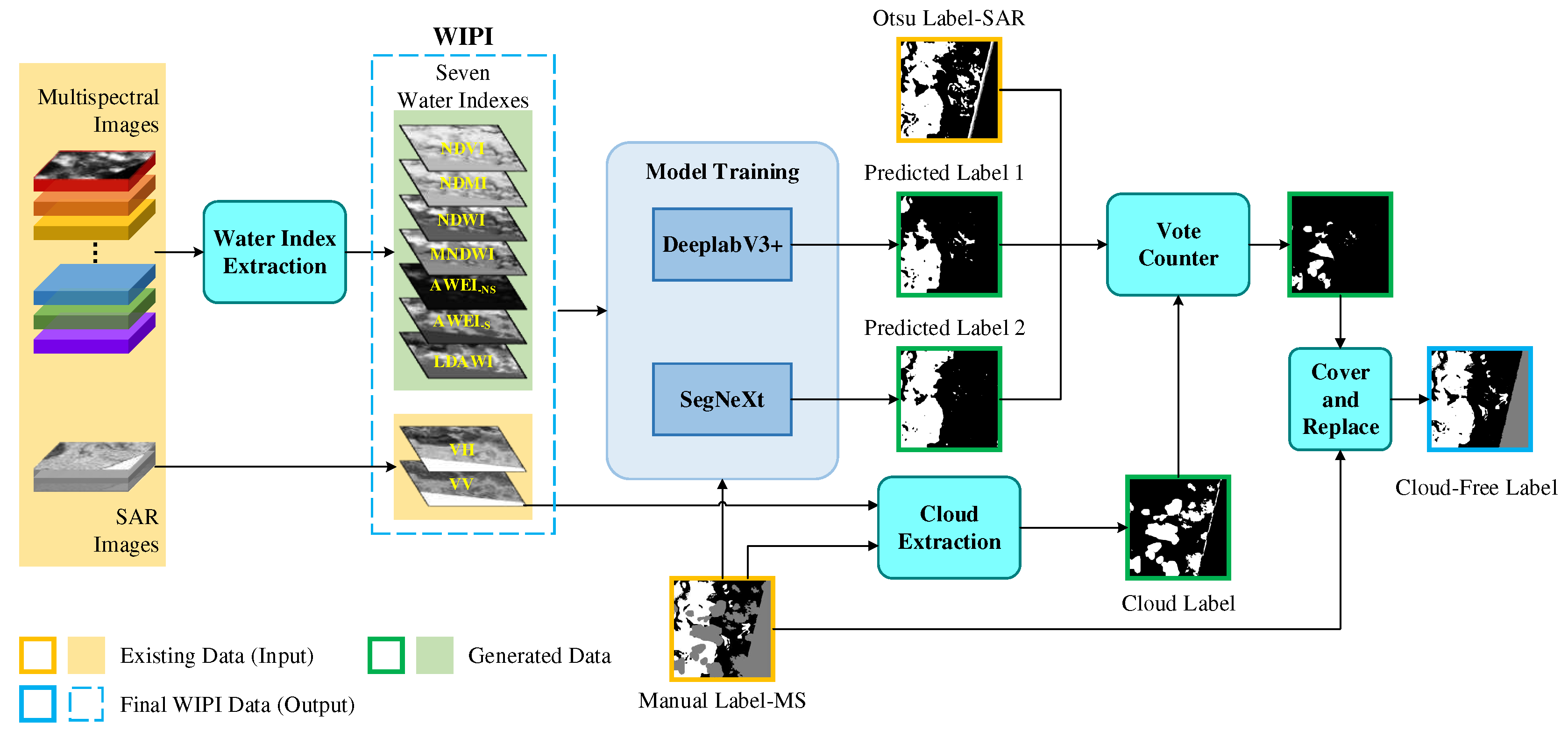
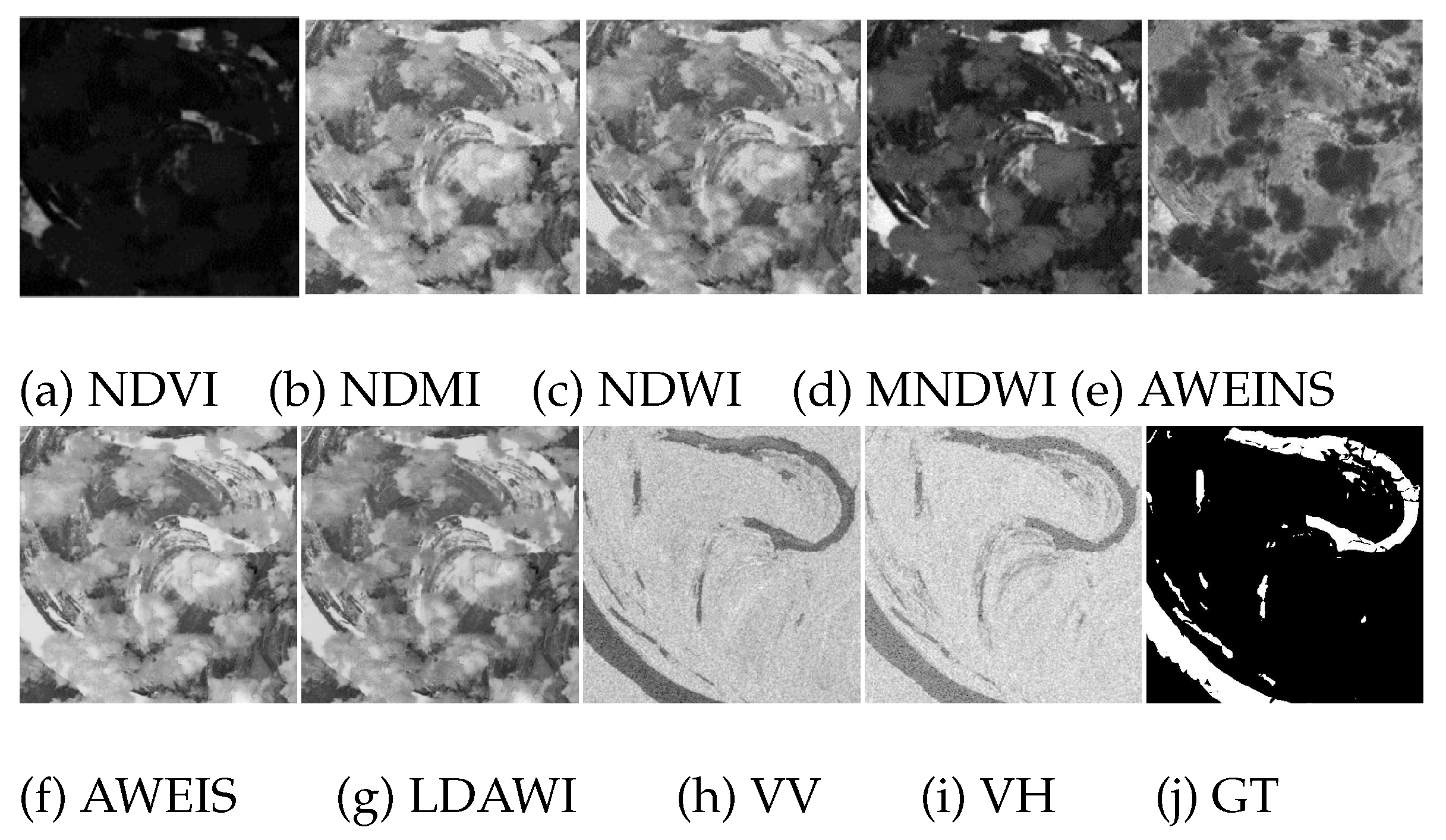
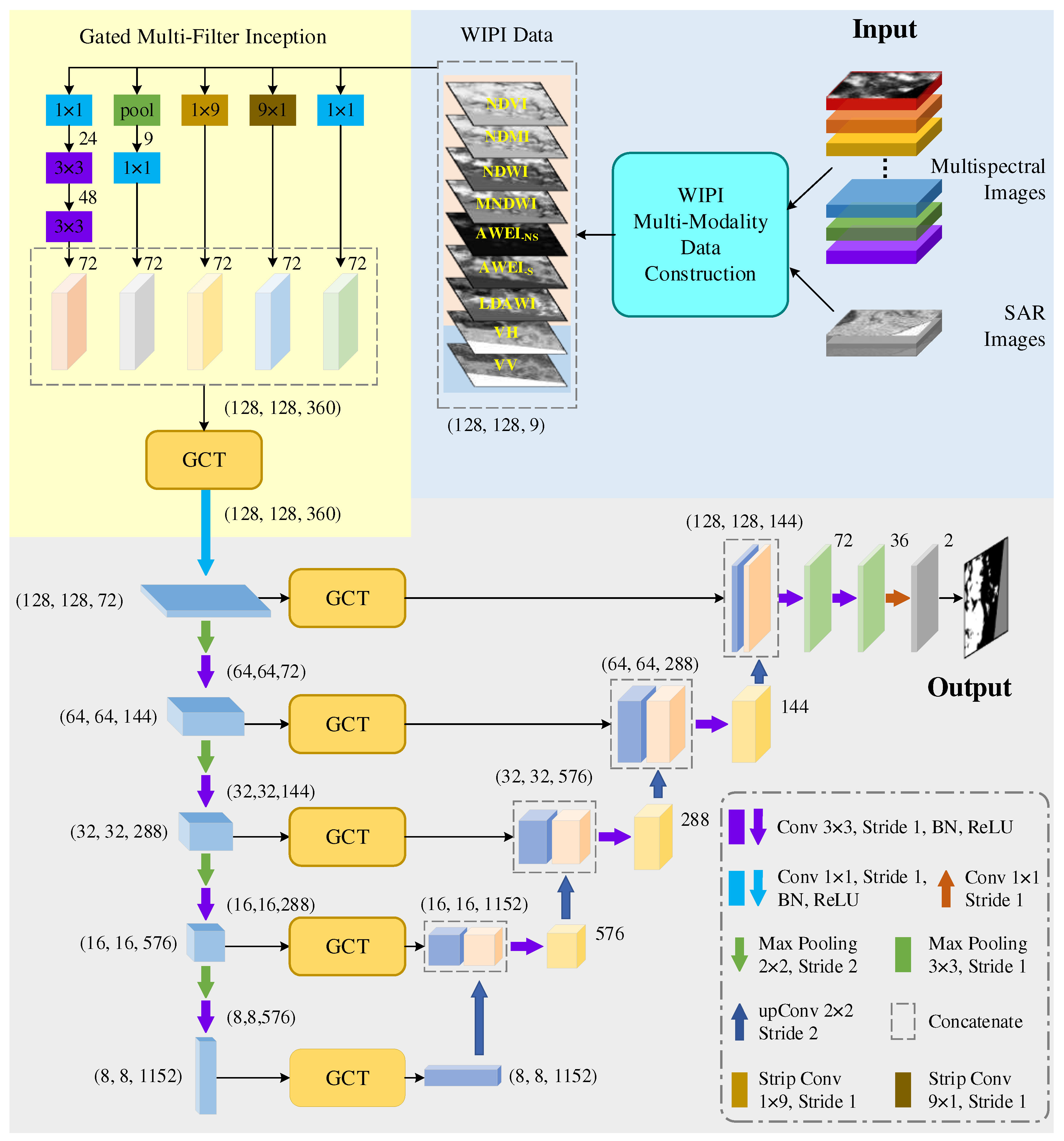

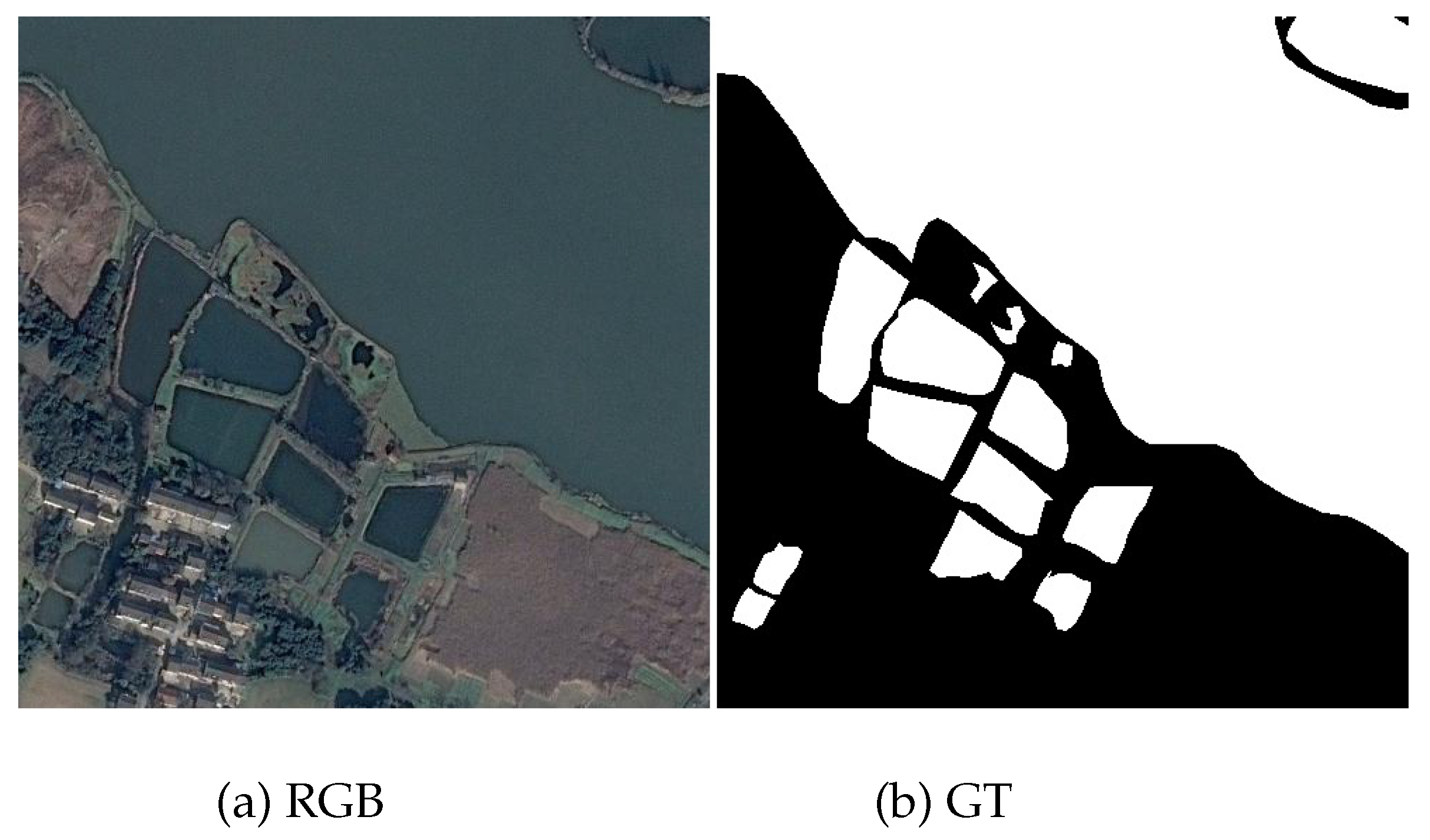
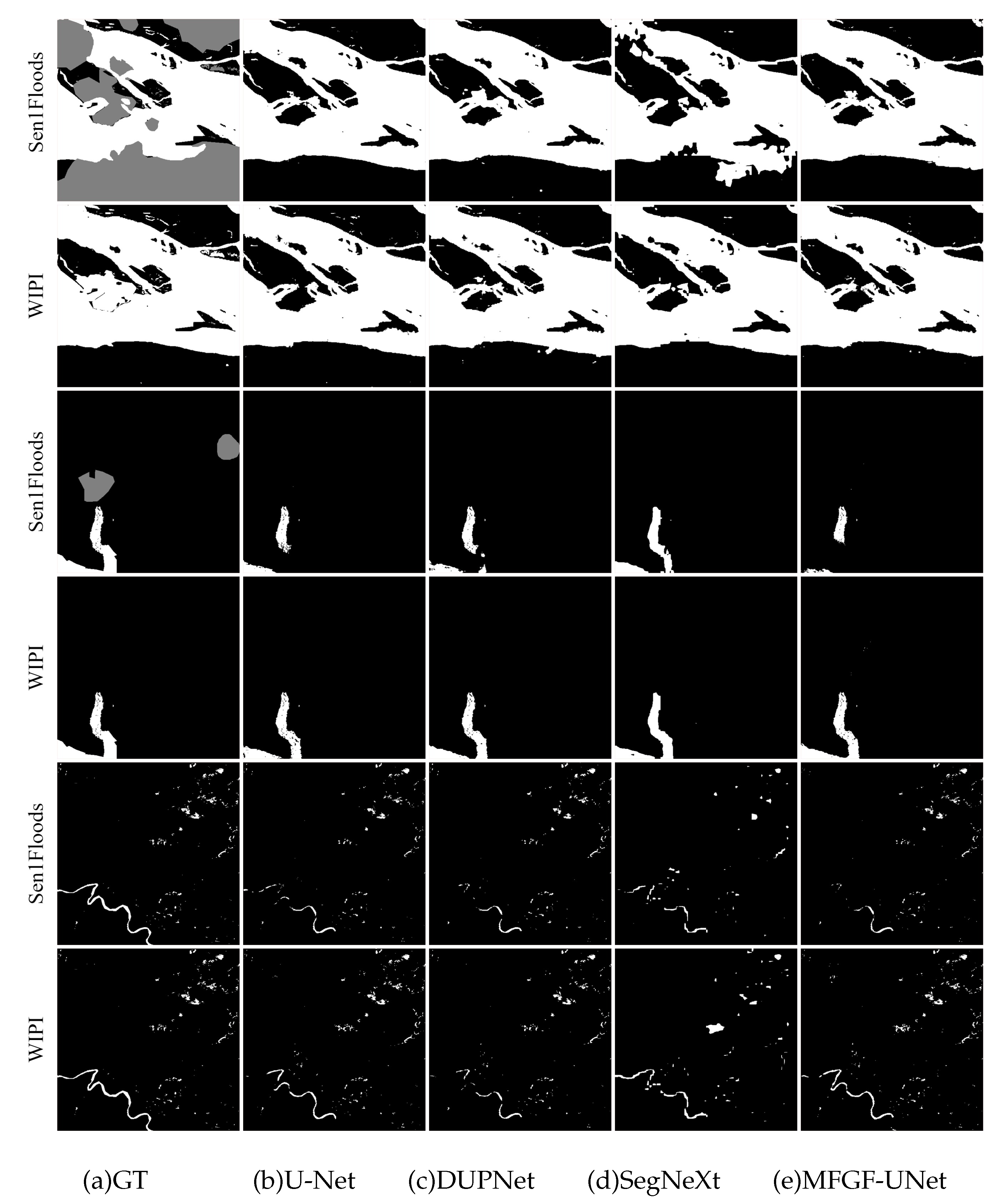
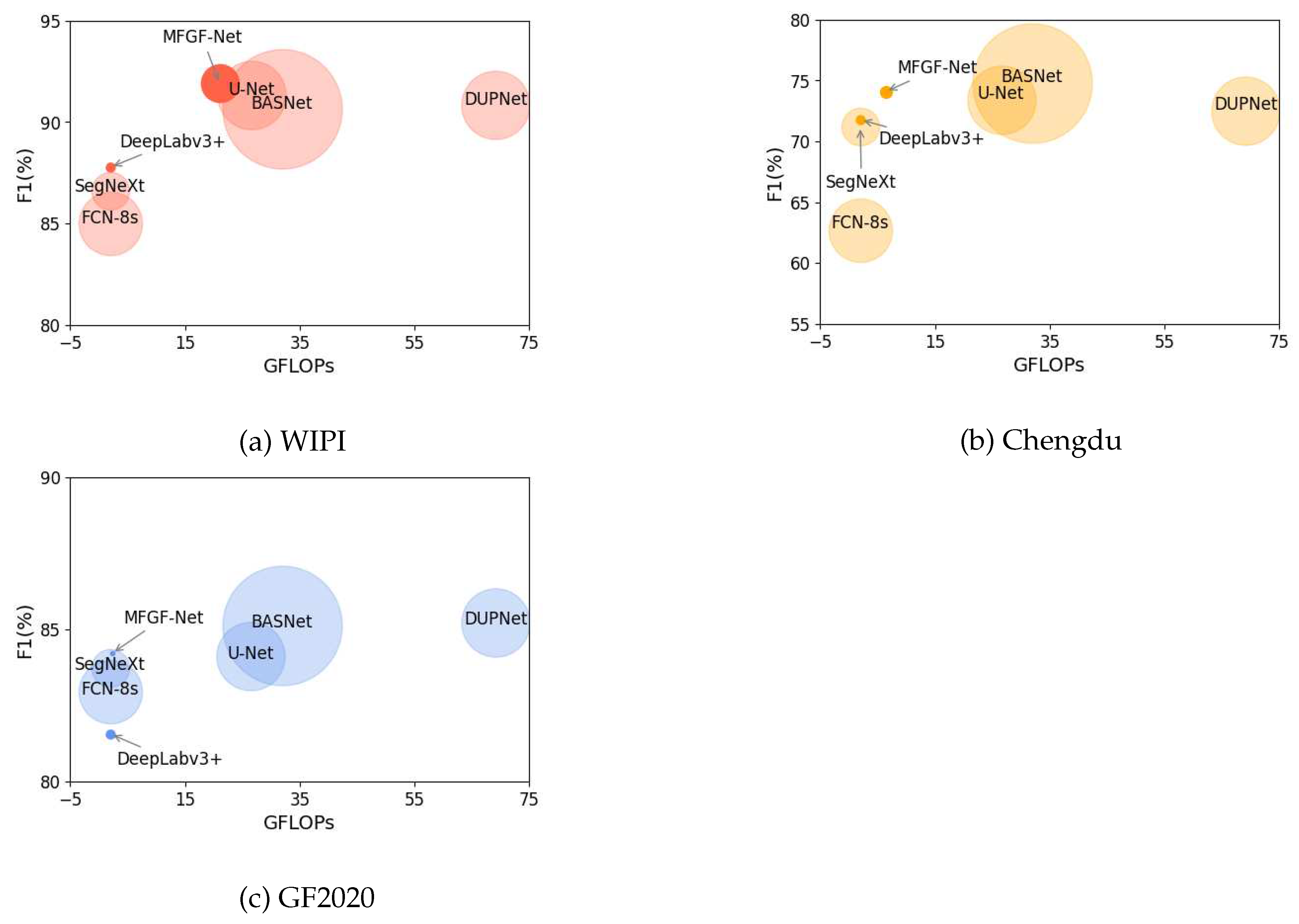
Disclaimer/Publisher’s Note: The statements, opinions and data contained in all publications are solely those of the individual author(s) and contributor(s) and not of MDPI and/or the editor(s). MDPI and/or the editor(s) disclaim responsibility for any injury to people or property resulting from any ideas, methods, instructions or products referred to in the content. |
© 2023 by the authors. Licensee MDPI, Basel, Switzerland. This article is an open access article distributed under the terms and conditions of the Creative Commons Attribution (CC BY) license (http://creativecommons.org/licenses/by/4.0/).




